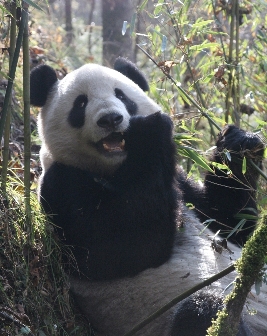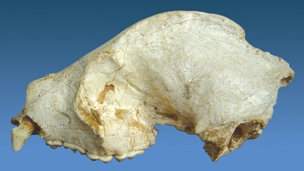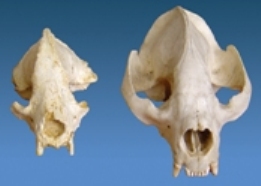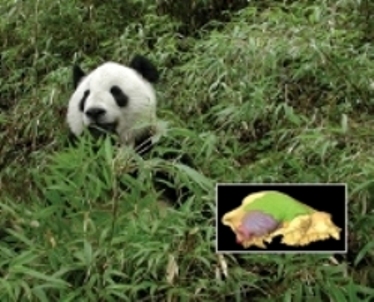Bamboozled! The Curious Natural History of the Giant Panda Family
20 Jul, 2007 01:44 pm
The discovery of the earliest giant panda skull has established that the giant panda lineage has been eating bamboo for more than 2 million years. This reliance on bamboo may figure prominently in its survival as a species, as well as affecting their size and even the panda?s thumb!
 In the 1980s, the earliest panda-like bear was discovered in Lufeng, southwest China’s Yunnan Province and dated to 7 million years ago during the Miocene epoch. Unfortunately, these remains were nothing more than fossil teeth, so little could be gleaned of its life except that it appeared to have crushing molars typical of its living relatives.
In the 1980s, the earliest panda-like bear was discovered in Lufeng, southwest China’s Yunnan Province and dated to 7 million years ago during the Miocene epoch. Unfortunately, these remains were nothing more than fossil teeth, so little could be gleaned of its life except that it appeared to have crushing molars typical of its living relatives. Photo: Giant Panda in bamboo forest habitat. Credit: Rongping Wei, Wolong Giant Panda Reserve Centre.
Fast forward to 2001, and a research expedition, organized by Wei Dong and Changzhu Jin of China’s Institute of Vertebrate Paleontology and Paleoanthropology (IVPP), set out to fill in the blanks in the panda lineage. Acting on tips from local farmers, six panda fossils were discovered in Jinyin Cave, south China's Guangxi Zhuang Autonomous Region. This time, luck was on their side and a beautiful skull was unearthed, providing the first face of the panda lineage!
The skull in question belongs to a miniature version of the giant panda species that lived between 2.4 and 2 million years ago. Lead author, Jin says that the “pygmy" giant panda (formally known as Ailuropoda microta) was likely a third smaller than today's pandas, coming in at an estimated three feet in length, when compared to more than five feet in the living species.
 Photo: Left side view of new fossil panda skull, Ailuropoda microta, from Jinyin Cave, Guangxi. Credit: Institute of Vertebrate
Photo: Left side view of new fossil panda skull, Ailuropoda microta, from Jinyin Cave, Guangxi. Credit: Institute of Vertebrate Paleontology and aleoanthropology,
Nevertheless, the teeth of the panda are so distinctive, that it is still possible to recognize this hobbit-sized bear as a relative, complete with many of the same cranial features. The full results of this intriguing find are published in the respected journal, Proceedings of the National Academy of Sciences this June, though the results will appeal to scientists and laymen alike. To fully appreciate these, however, some background on pandas and bears in general is necessary.
The diminutive size of these early pandas may come as a surprise to some, but in fact the label of “pygmy” is a bit of a misnomer. The small new skull is of the Giant Panda before they became big, so no dwarfing occurred. The first genus attributable to the living bears, Ursavus, didn’t appear until 20 mya and its fossils are known until about 7 mya. The modern bear species we’re familiar with today likely evolved from a descendant of Ursavus in the early Pliocene (4-5 mya), at the same time that humans were first evolving from our chimp-like relatives. This is considered a rather late start by evolutionary terms, but bears, like humans, have proved to be late bloomers. The earliest members of the bear family (Ursidae) were only the size of a large domestic housecat, not achieving their impressive present sizes until much later. Co-author, Russell Ciochon, of the University of Iowa observed that, “the large body size of the giant panda is an adaptation to its diet. Much like the vegetarian gorilla, the low body surface area to body volume is indicative of a lower metabolic rate. This lower metabolic rate and a more sedentary lifestyle allow the giant panda to subsist on nutrient poor resources such as bamboo.”

Photo: New fossil panda skull, Ailuropoda microta (left lower), is compared with a living giant panda skull, Ailuropoda melanoleuca (right upper). Credit: Institute of Vertebrate Paleontology and Paleoanthropology,
Diet eccentricities, as it turns out have long marked the ursid family. Of all other members of the order Carnivora, bears have modified carnassial teeth that instead of being used for shearing and tearing meat, have been modified for use grinding a more omnivorous diet. The panda takes this dietary idiosyncrasy to its extremes, as they are almost exclusively restricted to bamboo, with only occasional supplementation from honey, fish, eggs, and yams. This specialization for bamboo eating is curious in that their gut is still that of a carnivore and they receive little nutritive value from the shoots they eat. This paradox leads the panda to eat as much as 20 to 30 pounds of bamboo a day in an effort to keep their Buddha-like bellies full. Since the giant panda's rate of energy intake is not much greater than its energy expenditure, they tend to stick to gentler mountain slopes and avoid social interactions in order to save their strength.
The panda’s skull is more than just a pretty face; the round and cherubic features are the result of powerful chewing musculature, and are present in the recent discovery. The pygmy giant panda’s skull indicates strong muscle markings for the attachment of robust chewing muscles, like those needed to process a tough and woody diet. Also evident from the diminutive skull are the flat grinding surfaces of the teeth, the better to crush bamboo with! Indeed, these features, taken in total, have led scientists to realize that the giant panda’s reliance on the woody grass is nothing new. This is supported, says bamboo expert, Lynn Clark of Iowa State University in Ames, by evidence from grass macro and microfossils. Indeed, “all of the major lineages of grasses, including bamboos, appear to have been present by the end of the Miocene.” Co-author, Ciochon explains, “the combination of bamboo fossils and our new pygmy skull show the great time depth of this unique bamboo-eating specialization in pandas. From these features, we infer that pandas have been “bamboozled” for many millions of years!”
 Photo: Giant Panda in bamboo forest habitat (upper left) is pictured with a 3D reconstruction of new fossil panda skull (inset box at lower right). Credit: Rongping Wei, Wolong Giant Panda Reserve Centre and Institute of Vertebrate
Photo: Giant Panda in bamboo forest habitat (upper left) is pictured with a 3D reconstruction of new fossil panda skull (inset box at lower right). Credit: Rongping Wei, Wolong Giant Panda Reserve Centre and Institute of VertebratePaleontology and Paleoanthropology,
Part and parcel of this reliance on bamboo are other curious panda adaptations. The panda is also noted for its unusual paws, which seem to have five fingers and a thumb. This curious trait was even featured as the subject of a well-known essay by the late evolutionary biologist, Stephen Jay Gould. The “thumb”, however, turns out to be an evolutionary ruse and is merely a modified radial sesamoid bone (a bone that grows within a tendon, like the kneecap), which allows the pandas to better grip their bamboo. Unlike, the raccoon (a distant ursid relative), however, who has a true opposable 1st digit, the panda sports a stubby faux digit that is merely capable of squeezing, but not opposing the other true digits. This innovation is thought to be indicative of an unique adaptation to bamboo, as all other canoids (dogs, bears, pandas, weasels) have this bone, though none have it modified for use as a thumb, as does the panda. Whether the pygmy giant panda already had this unconventional adaptation at 2 million years ago or whether it evolved later, only time and more complete panda fossils will tell.
Russell L. Ciochon is professor of anthropology and department chair in the University of Iowa College of Liberal Arts and Sciences. K. Lindsay Eaves-Johnson is a PhD candidate in the Department of Anthropology at the University of Iowa College of Liberal Arts and Sciences.
Reference:
Jin C., et al, The first skull of the earliest giant panda, PNAS, published online before print June 19, 2007







 Read more
Read more
Good-Bye.